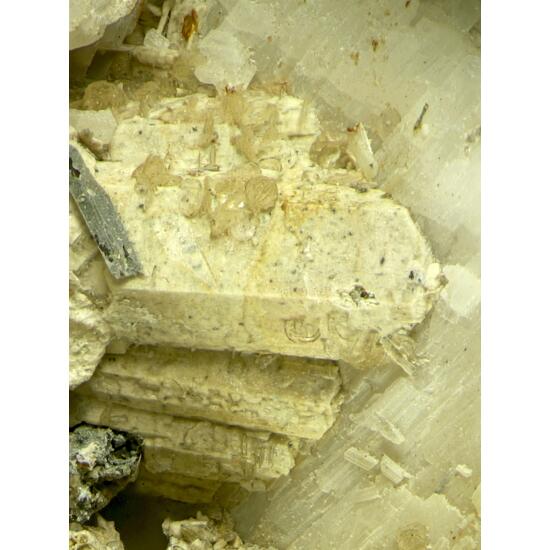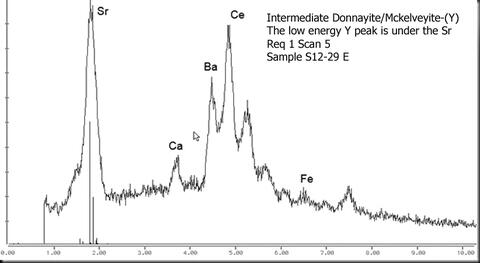MSH is well known not only for its spectacular array of rare and well-formed minerals, it is also well known - perhaps notorious - for its wide range of amazing, but often perplexing, pseudomorphs. This is a very good example of pseudomorphs of bastnäsite-(Ce), probably with synchysite-(Ce), after petersenite-(Ce) from the famous Poudrette pegmatite. (See below for more on the ID.) In addition, there also pseudomorphs of calcite and fluorite after shortite. A very complex and interesting specimen!
What makes this specimen good is the fact that the pseudomorphs are very sharply formed and many have “terminations” (although they are only partly visible because the “crystals” run nearly from wall to wall and into each other.) In addition, the pseudomorphs host small rosettes of an interesting donnayite group mineral of an unusual flat-tabular habit (rather than the more typical cone shaped crystals).
Pseudomorphs of synchysite-(Ce) after petersenite-(Ce) and/or rémondite-(Ce) were fairly common in the Poudrette pegmatite. See for example p. 57 of the Lapis special issue on MSH (July/Aug 2000) or p. 98 of “Minéraux du mont Saint-Hilaire” (ISBN 978-2-9814937-0-5). These pseudomorphs come in several sub-types. Perhaps the most common are the pale tan PSMs of synchysite-(Ce) after petersenite-(Ce). These have a very characteristic “swirly” surface texture, due to the synchysite being almost micaceous. The pseudomorphs on this specimen are of a less common type in which bastnäsite-(Ce) predominates. (See below for details.)
In some cases there is relict petersenite-Ce) (or rémondite-(Ce)). But in this case (as is most common) there is not. The interiors are honeycombed and partly hollow. So I can’t really be sure that the precursor was petersenite-(Ce) rather than rémondite-(Ce). However, despite having the same space group, these two minerals have fairly distinct habits at MSH, and the PSMs look as if they started out as petersenite-(Ce). But that’s just my best guess. Strictly speaking, these are PSMs after “burbankite family”.
Both the “donnayite group” and the PSMs were analyzed via qualitative EDS. (See the "Analysis" tab.) The scan (#311) for the “donnayite” (on a similar specimen) shows Sr > Ba, so given that the equipment is more sensitive to Ba than to Sr, this is probably more donnayite than mckelveyite (or ewaldite). But only WDS (plus XRD) could tell for sure. See the "Wonkish notes" at the end of the photo descriptions for more details on the IDs.
The first pair of photos (FOV 4.3 x 6.3 mm) shows a very sharp PSM 4.9 mm tall. It is “terminated”, but the termination is mostly obscured by the aegirine above it. Note the small, but very sharply formed “donnayite” plates, on the PSM.
The second pair of photos (FOV 6.9 x 4.5 mm) shows two more PSMs, the larger one is only partly visible. Is is actually about 1 cm long. The PSMs also have “donnayite” rosettes growing on them. The largest donnayite crystals are < 0.4 mm.
The third pair of photos (FOV 4.7 x 6.3 mm) shows yet more sharp PSMs. All of them run in to a “wall” of microcline and only small parts of the terminations were free to develop. There are a lot of “donnayite” rosettes, the largest ca 0.45 mm.
The fourth pair of photos (FOV 4.15 x 6.45 mm) shows some of the calcite & fluorite PSMs. They are somewhat stuck in a cavity and I couldn’t get a good angle of view. In any case, the image of the larger crystal wouldn’t fit on the camera sensor anyway. (For an example of similar PSMs – without the fluorite - see p. 96 of “Minéraux du mont Saint-Hilaire”.)
Wonkish notes on the IDs – for masochists only:
There is also a lot of Ce and La I n the EDS scans, and the low-energy Y peak isn’t very evident. This might suggest intergrowth with synchysite-(Ce) – which is a common thing at MSH. However, the Y peak is merely “hiding” under the Sr peak. I have included a high-voltage scan (#5b) for similar material from a nearby find which shows a clear Y peak at higher energy, but a similarly hidden Y peak at low energy (scan #5). As for the Ce and La – they seem to be a common feature of EDS scan for “donnayite” group at MSH. Another indication that there is little if any synchysite mixed in is the relatively low Ca peak.
However EDS scans for somewhat similar specimens have shown scans intermediate between synchysite-(Ce) and parisite-(Ce). XRD on another specimen showed parisite-(Ce). For this specimen, the sample was prepared by first removing soluble carbonates (such as synchysite-(Ce)) with dilute HCl. The resulting EDS scan (#365) shows a spectrum that is intermediate between bastnäsite-(Ce), and parisite-(Ce), but closer to bastnäsite-(Ce). (There is also residual Cl from the HCl.) Since part of the sample dissolved more or less rapidly, probably synchysite-(Ce) was also present. (Bastnäsite-(Ce) and parisite-(Ce) are soluble only with difficulty.)
Single item shipping weight (no case) is 5.7 oz (162 g). For shipments outside the USA, up to a total weight < 8 oz (225g), this can be combined with items from this or other auctions for the same postage.
Within the USA, postage for total weights up to 13 oz, ranges from $4.50 to $6.50 (including packing etc) regardless of destination. Above 13 oz, I will use Priority Mail ($7.25 - $9.20 including packing – varies by destination).

































